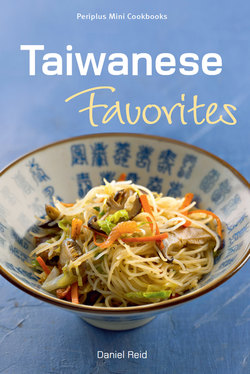Читать книгу Mini Taiwanese Favorites - Reid - Страница 4
Оглавление“Jia peng!”(“Let’s eat!”)—one of the most frequently heard phrases in the streets and homes of “Isla Formosa,” the “Beautiful Island,” better known today by its modern Chinese name, Taiwan. First settled by Chinese migrants fleeing dynastic change on the mainland during the late-17th century, Taiwan has since served as an escape hatch from China during hard times and as a repository for traditional Chinese culture. Among the cultural treasures preserved are some of the most ancient gems of Chinese cuisine, as well as the grand epicurean spirit of Chinese dining.
Unlike many regions of mainland China, where geography and climate often conspire to limit the quantity and range of foodstuff, Taiwan’s lush green mountains, fertile farmlands and abundant rainfall have always produced a rich cornucopia of food crops and livestock for the kitchen, enabling the Chinese chefs of Taiwan to exercise their traditional culinary skills to full gourmand potential. Every variety of fresh garden vegetable is available throughout the year in Taiwan and a bountiful abundance of all kinds of fresh seafood is hauled in daily from the island’s semi-tropical seas. For those who like to cook Chinese food—or wish to learn how—a period of residence in Taiwan offers the opportunity to practice China’s complete culinary curriculum without restraint.
Fresh seafood ranks among the island’s favorite fare and the Taiwanese are especially fond of the humbler species such as cuttlefish, squid and various shellfish, particularly oysters, clams and prawns. This is the stuff of night-markets and streetside stalls, as well as a mainstay of Taiwanese home cooking. Pork is by far the foremost choice on Taiwanese menus and chicken is the most popular selection in poultry.
Many of China’s ancient styles of cooking and seasoning remain prominent in contemporary Taiwanese kitchens. The thick, rich stew or soup known as tang, one of the oldest dishes on record in Chinese cuisine, is still very popular in Taiwan and is served in many forms and flavors in night-market stalls and roadside restaurants throughout Taiwan. Salted black beans, a strong-tasting cooking condiment that long pre-dates soy sauce or sesame oil in Chinese cookery, still appears in almost all kitchens in Taiwan and is used to flavor many dishes, especially seafood.
For fresh spice, Taiwanese cooks rely heavily on garlic, chili and ginger. They often garnish their dishes with generous portions of coriander and basil. The latter is known in Chinese as jiu ceng ta (“Nine Tiered Pagoda”) due to the structure of the plant’s flowering tops and its piquant flavor and fragrance have become hallmarks of Taiwanese cuisine.
Taiwanese style cooking, which originally developed as a culinary offshoot of coastal Fujian, from where the earliest Chinese settlers came, has gradually evolved to encompass elements from all of China’s regional traditions, all woven together in a unique local style that reflects the island’s rich bounty of cooking ingredients and its robust chi, he, wan, le (“eat, drink and be merry”) way of life. Rare is the meal in Taiwan that doesn’t include beer, wine, or spirits and you won’t find a restaurant, food stall, or home dining table on the entire island that doesn’t buzz with the excited laughter and chatter known in Chinese as re nau—“heat and noise.”
